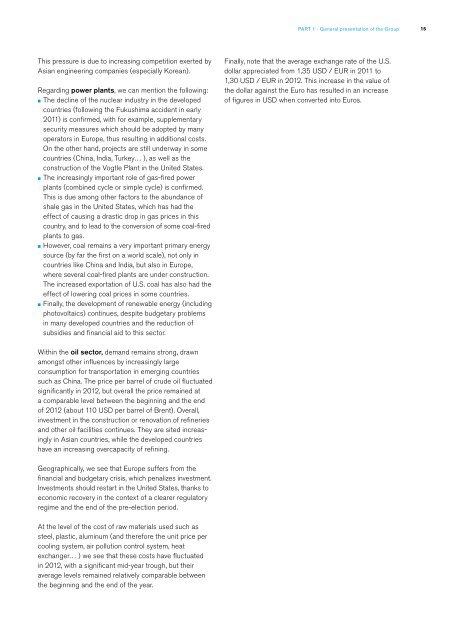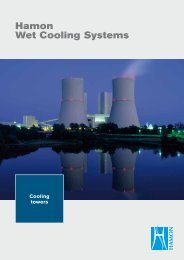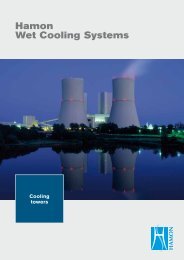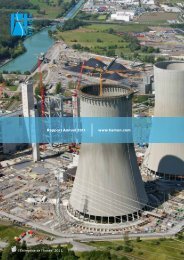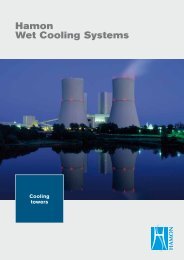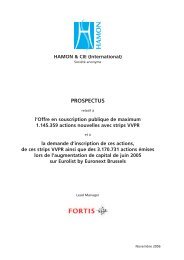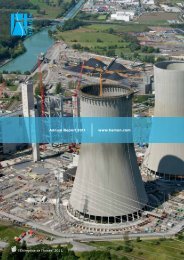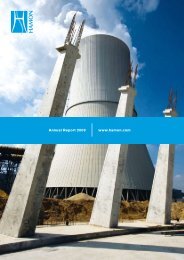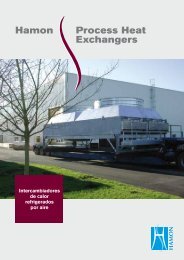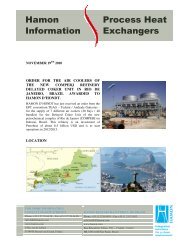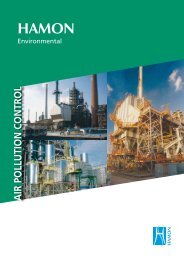Download PDF version English (3237KB) - Hamon
Download PDF version English (3237KB) - Hamon
Download PDF version English (3237KB) - Hamon
You also want an ePaper? Increase the reach of your titles
YUMPU automatically turns print PDFs into web optimized ePapers that Google loves.
Part 1 - General presentation of the Group<br />
15<br />
This pressure is due to increasing competition exerted by<br />
Asian engineering companies (especially Korean).<br />
Regarding power plants, we can mention the following:<br />
■ The decline of the nuclear industry in the developed<br />
countries (following the Fukushima accident in early<br />
2011) is confirmed, with for example, supplementary<br />
security measures which should be adopted by many<br />
operators in Europe, thus resulting in additional costs.<br />
On the other hand, projects are still underway in some<br />
countries (China, India, Turkey… ), as well as the<br />
construction of the Vogtle Plant in the United States.<br />
■ The increasingly important role of gas-fired power<br />
plants (combined cycle or simple cycle) is confirmed.<br />
This is due among other factors to the abundance of<br />
shale gas in the United States, which has had the<br />
effect of causing a drastic drop in gas prices in this<br />
country, and to lead to the con<strong>version</strong> of some coal-fired<br />
plants to gas.<br />
■ However, coal remains a very important primary energy<br />
source (by far the first on a world scale), not only in<br />
countries like China and India, but also in Europe,<br />
where several coal-fired plants are under construction.<br />
The increased exportation of U.S. coal has also had the<br />
effect of lowering coal prices in some countries.<br />
■ Finally, the development of renewable energy (including<br />
photovoltaics) continues, despite budgetary problems<br />
in many developed countries and the reduction of<br />
subsidies and financial aid to this sector.<br />
Finally, note that the average exchange rate of the U.S.<br />
dollar appreciated from 1,35 USD / EUR in 2011 to<br />
1,30 USD / EUR in 2012. This increase in the value of<br />
the dollar against the Euro has resulted in an increase<br />
of figures in USD when converted into Euros.<br />
Within the oil sector, demand remains strong, drawn<br />
amongst other influences by increasingly large<br />
consumption for transportation in emerging countries<br />
such as China. The price per barrel of crude oil fluctuated<br />
significantly in 2012, but overall the price remained at<br />
a comparable level between the beginning and the end<br />
of 2012 (about 110 USD per barrel of Brent). Overall,<br />
investment in the construction or renovation of refineries<br />
and other oil facilities continues. They are sited increasingly<br />
in Asian countries, while the developed countries<br />
have an increasing overcapacity of refining.<br />
Geographically, we see that Europe suffers from the<br />
financial and budgetary crisis, which penalizes investment.<br />
Investments should restart in the United States, thanks to<br />
economic recovery in the context of a clearer regulatory<br />
regime and the end of the pre-election period.<br />
At the level of the cost of raw materials used such as<br />
steel, plastic, aluminum (and therefore the unit price per<br />
cooling system, air pollution control system, heat<br />
exchanger… ) we see that these costs have fluctuated<br />
in 2012, with a significant mid-year trough, but their<br />
average levels remained relatively comparable between<br />
the beginning and the end of the year.


